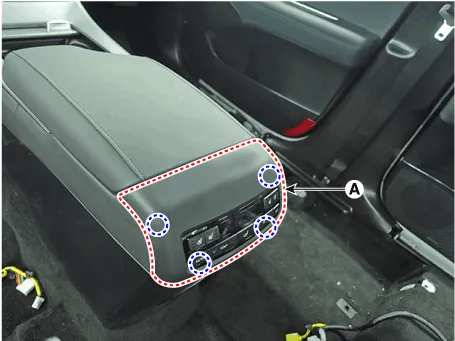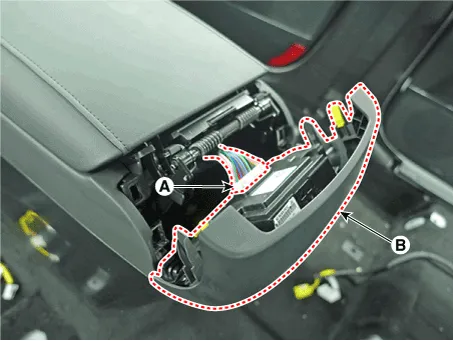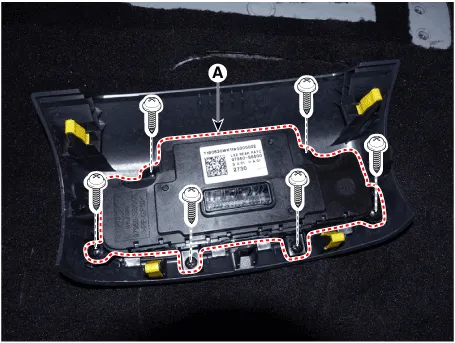Hyundai Palisade (LX2): Controller / Heater & A/C Control Unit (Rear)
Components and components location
| Component |

| Connector Pin Function |
|
Connector |
PIN No |
Pin Function |
Connector |
PIN No |
Pin Function |
|
A |
1 |
Battery |
A |
17 |
IGN2 |
|
2 |
ISG B+ |
18 |
IGN1 |
||
|
3 |
ILL+ (TAIL) |
19 |
Blower Motor (+) |
||
|
4 |
Sensor Ground REF (+5V) |
20 |
- |
||
|
5 |
Mode Control Actuator Feedback |
21 |
Mosfet (DRAIN F/B) |
||
|
6 |
Temperature Actuator Feedback |
22 |
Mosfet (GATE) |
||
|
7 |
Mode Control Actuator (Vent) |
23 |
Heater Switch _ LH |
||
|
8 |
Mode Control Actuator (Defrost) |
24 |
Indicator (HIGH) _ LH |
||
|
9 |
Temperature Control Actuator (Cool) |
25 |
Indicator (MID) _ LH |
||
|
10 |
Temperature Control Actuator (Warm) |
26 |
Indicator (LOW) _ LH |
||
|
11 |
Detent out (-) |
27 |
Heater Switch _ RH |
||
|
12 |
K - Line |
28 |
Indicator (HIGH) _ RH |
||
|
13 |
LIN Left |
29 |
Indicator (MID) _ RH |
||
|
14 |
Lin Right |
30 |
Indicator (LOW) _ RH |
||
|
15 |
- |
31 |
Sensor Ground |
||
|
16 |
ILL - (RHEO) |
32 |
Ground |
Repair procedures
| Replacement |
|
|
| 1. |
Disconnect the negative (-) battery terminal.
|
| 2. |
Using a flat-tip screwdriver or remover and remove the rear console
upper cover (A).
|
| 3. |
Press the lock pin and separate the rear console connector (A) and remove
the rear console upper cover (B).
|
| 4. |
Loosen the mounting screws and remove the rear heater & A/C control
unit (A).
|
| 5. |
To install, reverse removal procedure.
|
Components and components location Component Connector Pin Function Connector PIN No Pin Function Connector PIN No Pin Function A 1 Battery A 21 IGN2 2 ISG B+ 22 IGN1 3 ILL+ (TAIL) 23 Blower Motor (+) 4 Sensor Ground REF (+5V) 24 Photo Sensor (-)_LEFT 5 Mode Control Actuator Feedback 25 Photo Sensor (-)_RIGHT 6 Temperature Actuator Feedback - Driver 26 Incar Sensor (+) 7 Intake Actuator Feedback 27 Incar Motor (-) 8 Evaporator Temperature Sensor (+) 28 PTC Relay 3 9 Ambient Temperature Sensor (+) 29 PTC Relay 3 10 Mode Control Actuator (Vent) 30 PTC On Signal 11 Mode Control Actuator (Defrost) 31 Detent out (-) 12 Temperature Control Actuator (Cool) - Driver 32 K - Line 13 Temperature Control Actuator (Warm) - Driver 33 P_CAN High 14 Intake Actuator (Fresh Air) 34 P_CAN Low 15 Intake Actuator (Recirculated Air) 35 Mosfet (DRAIN F/B) 16 HTD (Rear Defrost) 36 Mosfet (GATE) 17 Rear Defogging Swich 37 ECV + 18 Clean Signal 38 ECV - 19 Ionizer Diagnosis 39 Sensor Ground 20 ILL - (RHEO) 40 Ground Connector PIN No Pin Function Connector PIN No Pin Function B 1 Temperature Control Actuator Feedback - Passenger B 9 - 2 Temperature Control Actuator (Cool) - Passenger 10 - 3 Temperature Control Actuator (Warm) - Passenger 11 - 4 Defogging Actuator Feedback 12 Defogging Sensor TEMP 5 Defogging Actuator (Open) 13 Defogging Sensor SCK 6 Defogging Actuator (Close) 14 Defogging Sensor Data 7 - 15 - 8 Seat Signal PWM - Driver 16 Ground Repair procedures Self Diagnosis 1.
Other information:
Hyundai Palisade (LX2) 2020-2025 Service Manual: PTC Heater (Diesel only)
Description and operation Description The PTC (Positive Temperature Coefficient) heater is installed at the exit or the backside of the heater core. The PTC heater is an electric heater using a PTC element as an auxiliary heating device that supplements deficiency of interior heat source in highly effective diesel engi
Hyundai Palisade (LX2) 2020-2025 Service Manual: Components and components location
Categories
- Manuals Home
- Hyundai Palisade Owners Manual
- Hyundai Palisade Service Manual
- Emergency liftgate safety release
- Convenient Features of Your Vehicle
- System Setting and Operation
- New on site
- Most important about car






